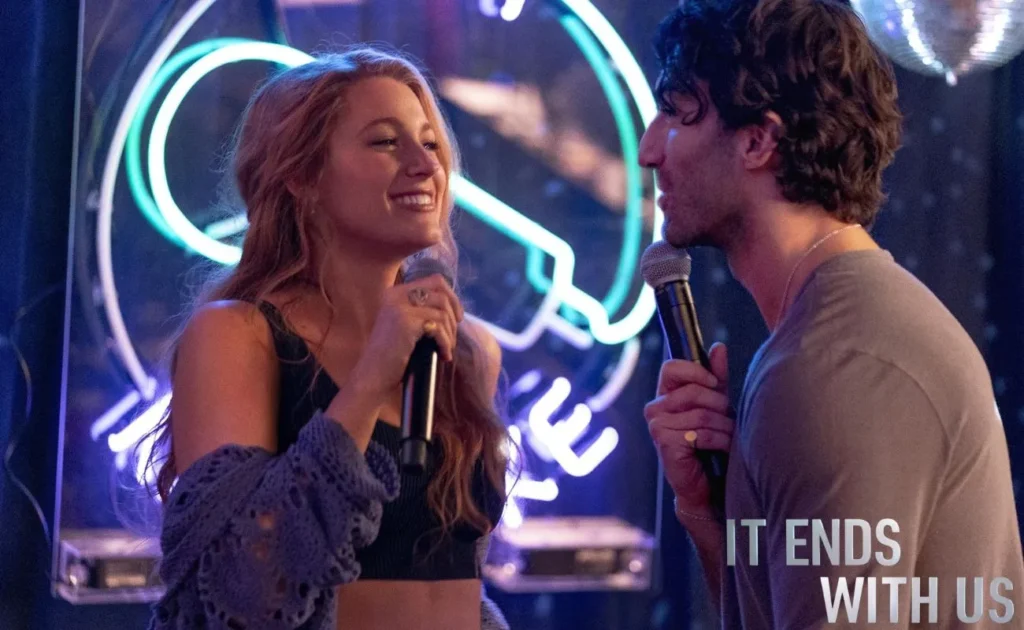
It Ends with Us, the film adaptation of Colleen Hoover’s bestselling novel, hit theaters on August 9, 2024, with a modest budget of $25 million. Directed by Justin Baldoni and starring Blake Lively, the movie delves into themes of love, trauma, and resilience. However, despite its strong source material and star-studded cast, the film has garnered mixed reviews.
It Ends with Us Review: A Story of Love, Trauma, and Healing
It Ends with Us follows the journey of Lily Bloom, played by Blake Lively, as she navigates the challenges of her past and present relationships. After a traumatic childhood marked by her father’s abuse, Lily is determined to build a better life for herself. She moves to Boston and opens a flower shop, a dream she’s nurtured for years. Her life takes a significant turn when she meets Ryle Kincaid (Justin Baldoni), a charming neurosurgeon who quickly sweeps her off her feet.
However, the story takes a darker turn as Lily’s past begins to catch up with her. Her first love, Atlas Corrigan (Brandon Sklenar), reenters her life, reigniting old emotions and complicating her relationship with Ryle. As Lily grapples with these conflicting feelings, the film delves into the painful cycle of domestic violence, mirroring the trauma she witnessed in her parents’ relationship.
A Strong Performance by Blake Lively
One of the film’s standout elements is Blake Lively’s performance as Lily. Lively brings both vulnerability and strength to the character, making Lily’s internal struggles feel palpable. Whether she’s portraying Lily’s hopefulness in love or her despair as old wounds are reopened, Lively’s portrayal adds depth to the character and keeps the audience engaged. Her ability to convey complex emotions helps to anchor the film, even when the narrative wavers.
Justin Baldoni, who also directs, plays Ryle with a mix of charm and intensity, making his character both appealing and unsettling. The chemistry between Lively and Baldoni is evident, though the film struggles to balance the romantic and darker elements of their relationship.
An Uneven Narrative
While It Ends with Us is rich in emotional moments, the film’s narrative structure feels uneven at times. The flashbacks to Lily’s teenage years, where we see her first love with Atlas, are touching and well-acted by Isabela Ferrer. However, these scenes are interspersed with the present-day storyline in a way that can feel disjointed. The connection between the past and present is not always clear, leaving the audience to piece together the relevance of these flashbacks on their own.
The film’s treatment of its heavy themes, such as domestic violence and generational trauma, is both its strength and its weakness. On one hand, it does not shy away from the harsh realities of abuse, making it a poignant and important watch. On the other hand, the romantic subplot sometimes undermines the gravity of these issues, turning the film into a melodrama that occasionally feels more like a soap opera than a serious drama.
Visuals and Cinematography
Visually, It Ends with Us is beautifully shot, with autumnal hues that evoke a sense of nostalgia and melancholy. The cinematography by Barry Peterson captures the intimate moments between characters, enhancing the emotional impact of the story. However, the film’s aesthetic sometimes feels at odds with its darker themes, creating a contrast that can be jarring.
The Good and the Bad
While the performances, particularly Lively’s, have been well-received, the film’s narrative structure and tone have been points of contention. The frequent flashbacks, which aim to provide context to Lily’s current struggles, sometimes disrupt the flow of the story, making the pacing feel uneven. This narrative choice, combined with the film’s shift between romance and darker themes, left some viewers feeling that the film was unsure of its identity.
Visually, It Ends with Us is appealing, with cinematography that captures the emotional highs and lows of the characters’ journeys. The autumnal color palette adds a layer of nostalgia and warmth, which contrasts with the more intense scenes of domestic conflict. However, this visual beauty sometimes feels at odds with the film’s darker moments, creating a dissonance that can be jarring for the audience.
Critical Consensus
It Ends with Us has sparked mixed reactions among critics and audiences alike. On Rotten Tomatoes, the film holds a 59% rating, indicating that while some viewers appreciated its emotional depth, others found it lacking in execution. IMDb users gave the film a more favorable 7.1/10, suggesting that the general audience might have connected better with the story and performances. However, on Metacritic, the film earned a score of 54%, reflecting the divided opinions of critics.
These scores encapsulate the film’s strengths and weaknesses: while it resonates emotionally with its target audience, particularly fans of the novel, it struggles to satisfy the broader critical community fully. The movie’s handling of complex themes like domestic violence and trauma is commendable, yet the uneven narrative and occasional melodramatic tone prevent it from achieving universal acclaim.
Final Verdict
It Ends with Us is a film that tries to do justice to its source material, but it doesn’t fully succeed. While Blake Lively’s performance and the film’s exploration of important themes make it worth watching, the uneven narrative and occasional melodramatic tone may leave some viewers wanting more. Fans of the book will appreciate seeing the story brought to life, but those unfamiliar with the novel might find the film’s pacing and tone to be inconsistent.
Overall, It Ends with Us is a heartfelt but flawed adaptation that shines in its portrayal of complex emotions but stumbles in its execution. It’s a movie that will resonate with its target audience, especially those who have connected deeply with Hoover’s novel, but may struggle to find its footing with a broader audience.
